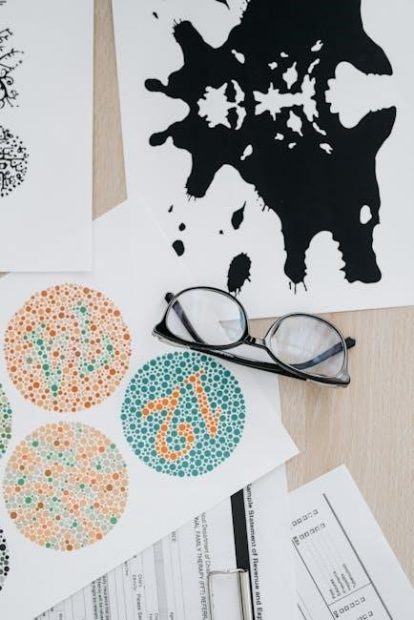The Ishihara Test, created by Dr. Shinobu Ishihara in 1917, is a widely used diagnostic tool for color vision deficiency. It employs colored dot patterns to reveal numbers or shapes, visible only to individuals with normal color vision. This test is particularly effective in identifying red-green color blindness, making it a standard in ophthalmology and optometry practices worldwide.
Overview of the Ishihara Color Blindness Test
The Ishihara Color Blindness Test is a widely recognized diagnostic tool designed to identify red-green color vision deficiency. Created by Dr. Shinobu Ishihara in 1917, it consists of 38 plates featuring intricate patterns of colored dots. These plates are used to assess an individual’s ability to perceive specific color wavelengths. The test is particularly effective in detecting congenital color vision deficiencies, which are the most common form of color blindness. Each plate contains a hidden number or shape, visible only to those with normal color vision. The test is straightforward, requiring individuals to identify the numbers they see, with scoring based on correct responses. Its simplicity and accuracy have made it a standard in optometry and ophthalmology. Additionally, digital versions and PDF downloads are now available, enhancing accessibility for self-assessment and professional use.

History and Development of the Ishihara Test

Developed in 1917 by Dr. Shinobu Ishihara, a Japanese ophthalmologist, the Ishihara Test was initially designed for military use to detect color vision deficiency in recruits. It quickly became a standard diagnostic tool worldwide.
Dr. Shinobu Ishihara and the Creation of the Test
Dr. Shinobu Ishihara, a renowned Japanese ophthalmologist, developed the Ishihara Test in 1917 to address the need for a reliable method to detect color vision deficiency. Initially designed for military recruitment, the test aimed to identify individuals with red-green color blindness, which was crucial for roles requiring accurate color perception. Ishihara’s innovative use of colored dots arranged in patterns revolutionized the field of optometry. His approach ensured that individuals with normal vision could discern numbers or shapes, while those with deficits could not. Over time, the test has undergone refinements but remains a cornerstone in diagnosing color vision deficiencies. Its simplicity and effectiveness have solidified its place as a standard diagnostic tool worldwide.

Structure and Components of the Ishihara Test
The Ishihara Test consists of 38 colored plates, including a demonstration plate and 37 test plates with hidden numbers or shapes, designed to assess red-green color vision.
The 38 Plates and Their Significance
The Ishihara Test comprises 38 plates, each serving a distinct purpose in diagnosing color vision deficiency. These plates are divided into several categories: demonstration plates to familiarize the test-taker with the format, hidden digit plates visible only to those with normal vision, and vanishing plates that appear differently to individuals with color vision deficiency. Additionally, some plates are designed to be invisible to those with specific types of color blindness, while others are meant to be seen by everyone, ensuring the test’s reliability. The plates use varying sizes and arrangements of colored dots to create patterns that reveal numbers or shapes, making the test both comprehensive and effective in identifying red-green color blindness. This structured approach ensures accurate diagnosis and has made the Ishihara Test a cornerstone in color vision assessment for over a century.

Normal and Abnormal Vision Interpretations
In the Ishihara Test, individuals with normal color vision can see numbers or shapes formed by the colored dots, while those with color vision deficiency may see different numbers, incomplete patterns, or nothing at all; For example, a person with normal vision might see a “3” or “12,” whereas someone with red-green color blindness might see a “5” or no number at all. The test is designed to reveal these differences clearly. Plates are arranged to ensure that individuals with normal vision consistently identify the correct patterns, while those with deficiencies struggle to do so. This contrast allows for accurate identification of color vision issues, making the Ishihara Test a reliable tool for diagnosing red-green color blindness and other vision deficiencies. The interpretations are straightforward, enabling quick and precise assessments of color perception abilities.

How the Ishihara Test Works
The Ishihara Test uses colored dot patterns to assess color vision. Numbers are visible to those with normal vision but appear differently or invisible to those with color blindness.
Color Perception and Dot Patterns
The Ishihara Test relies on color perception and intricate dot patterns to diagnose color vision deficiency. Each plate consists of dots varying in color, size, and brightness, forming numbers or shapes. Individuals with normal vision can see these patterns clearly, while those with color blindness may see distorted or invisible images. The test primarily targets red-green color blindness, using specific wavelengths to differentiate perceptions. The dots are arranged strategically, ensuring that only individuals with typical color vision can identify the hidden numbers or paths. This method leverages the brain’s ability to process color contrasts, making it a reliable tool for detecting deficiencies. The test’s design ensures accuracy, with sensitivity and specificity rates exceeding 97% and 100%, respectively, for red-green color blindness diagnosis.
Testing Procedure and Instructions
The Ishihara Test is administered using a book of 38 plates, each containing colored dot patterns. The test is typically conducted in a well-lit room with natural daylight to ensure accurate color perception. Individuals are instructed to identify numbers or shapes within the patterns. The test begins with a demonstration plate to familiarize the participant with the process. Each plate is shown for a limited time, usually 3 seconds, to simulate real-world conditions. The test administrator records the responses, noting correct and incorrect identifications. The results are scored based on the number of correct answers, with scores below 12 indicating potential color vision deficiency. The test is straightforward, requiring no prior preparation, and is suitable for both adults and children. Proper administration ensures reliable results, making it a trusted diagnostic tool for color blindness.

Interpreting Ishihara Test Results

Results are scored based on correct identifications of numbers or shapes. Scores below 12 indicate color vision deficiency, while 12 or more suggest normal vision. The test achieves 97% sensitivity and 100% specificity, ensuring reliable diagnoses for red-green color blindness.
Scoring and Diagnosis of Color Vision Deficiency
The Ishihara Test results are evaluated based on the number of correctly identified plates. A score of 12 or more out of 14 red-green test plates indicates normal color vision, while scores below 12 suggest a color vision deficiency. This method ensures high accuracy, with 97% sensitivity and 100% specificity, making it a reliable diagnostic tool. The test primarily identifies red-green color blindness, the most common form of color vision deficiency. Each plate is designed to reveal specific patterns or numbers visible only to individuals with normal vision, allowing for precise detection of deficiencies. The Ishihara Test remains a standard in ophthalmology and optometry for its simplicity and effectiveness in diagnosing color vision impairments.
Accuracy and Reliability of the Test
The Ishihara Test demonstrates high accuracy and reliability in diagnosing color vision deficiency, particularly red-green color blindness. With 97% sensitivity and 100% specificity, it effectively distinguishes between normal and deficient color vision. The test’s reliability is enhanced by its standardized design, ensuring consistent results across administrations. However, factors like variations in digital screen settings can affect online versions, potentially altering outcomes. To maintain accuracy, the test is best administered under controlled conditions with physical plates. While it is a highly reliable tool, it should be part of a comprehensive eye examination for a complete diagnosis. Its proven track record over a century underscores its value in ophthalmology and optometry for assessing color vision impairments.

Modern Applications and Variations
The Ishihara Test is now available in digital formats, including downloadable PDFs, and companies like EnChroma offer advanced online versions for broader and more convenient color vision assessment.
Digital and Online Versions of the Ishihara Test
Digital versions of the Ishihara Test have revolutionized color vision assessment, offering convenience and accessibility. Online platforms now provide interactive tests, allowing users to identify color blindness from home; PDF versions of the test are also widely available for download, enabling individuals to print and use the plates at their convenience. These digital formats maintain the original structure of 38 plates but incorporate advanced algorithms to enhance accuracy. For example, EnChroma’s online test uses cone isolation technology to assess color perception more precisely. Additionally, digital tools often include scoring systems and detailed interpretations, making self-assessment easier. However, variations in screen color settings can affect results, emphasizing the need for standardized digital displays. Despite these advancements, the core principle of using dot patterns to detect color vision deficiency remains intact, ensuring reliability and consistency across formats.
Alternatives and Advances in Color Blindness Testing
Beyond the Ishihara Test, modern advancements have introduced alternative methods for diagnosing color vision deficiency. Digital tools like EnChroma’s cone isolation technology offer precise assessments by targeting the sensitivity of individual color-sensing cones. Similarly, Colorlite tests expand beyond red-green deficiency to include blue (Tritan) color blindness. Online platforms and apps now provide interactive testing, enabling users to identify deficiencies from home. These innovations improve accessibility and accuracy, addressing limitations like screen color variability. Despite these advancements, the Ishihara Test remains a cornerstone due to its simplicity and reliability. However, combining it with newer technologies ensures a more comprehensive evaluation of color vision. These alternatives not only enhance diagnostic capabilities but also pave the way for personalized treatments, such as specialized glasses or contact lenses designed to aid color perception.
